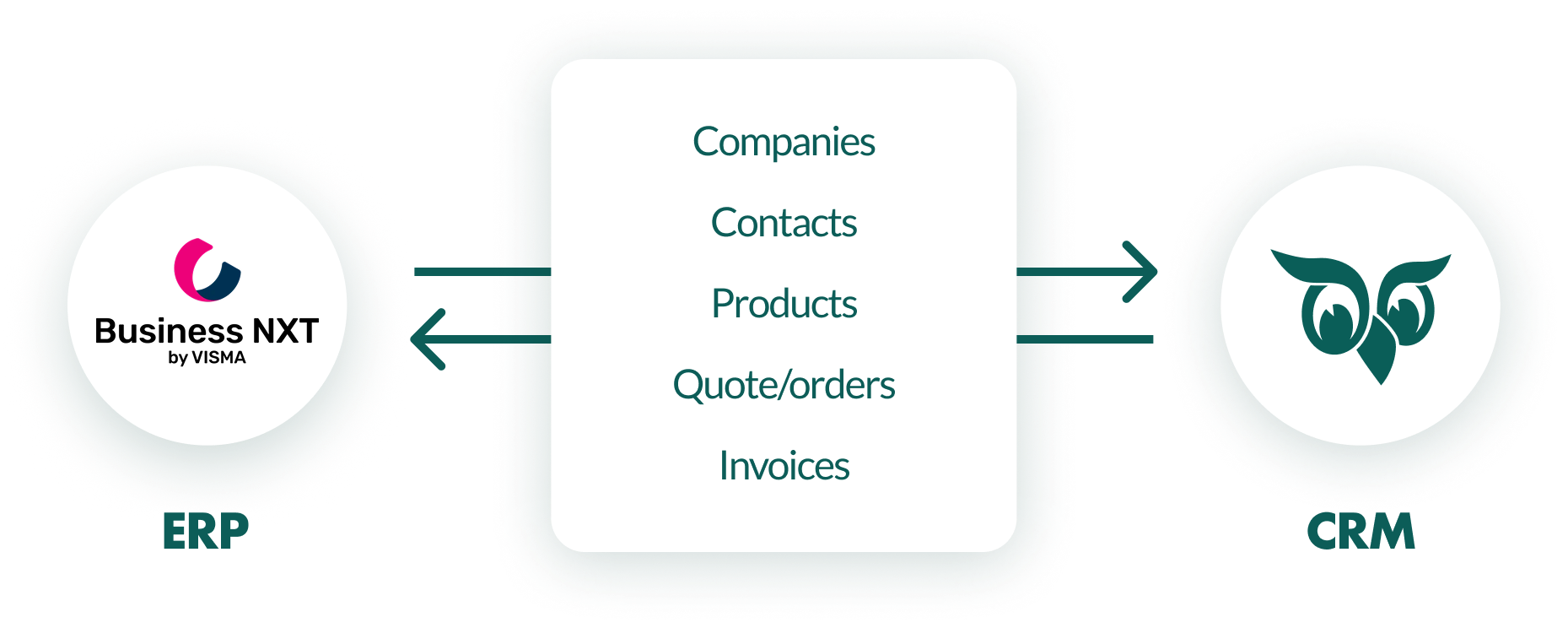Elevate your business with ERP and CRM integration
Some things are simply better together - like ERP and CRM. Integrate your accounting system with a CRM to match the resources you have with what your customers need. Let's show you how.

Your erp knows the history - what about the future?
Your ERP system is great at tracking past transactions and monitoring current inventory, but what about predicting future sales or uncovering hidden opportunities?
Without a CRM you’re left guessing, stuck with manual processes, and dealing with errors from spreadsheets that don’t scale. By integrating your ERP with a CRM, you connect the dots between history and potential.
Turn raw data into actionable insights, unlock growth opportunities, and free your team from time-consuming manual tasks. Navigate your company’s sales—past, present, and future—with clarity and confidence.

How it works
-
Connect your ERP and CRM platforms
-
Synchronize live data automatically
-
Start using combined insights for daily operations
Skip the silos
Connect marketing and sales efforts to work as one force on the same goal. Secure communication, avoid duplication of work, and lay the foundation for good team collaboration.

Scale beyond spreadsheets and manual processes
More customers equal a more complex sales process. When combining ERP and CRM, you get scalable efficiency unlike any other.

Keep and expand important knowledge
Your team knows important customer knowledge and resilience. Combining ERP and CRM ensures critical insights are saved and shared across teams, expanding valuable information - even during employee transitions.

One connection. Endless clarity
ConnectERP brings your customer relationships and business operations together in one place. No more data silos, manual work, or missed opportunities. Just real-time insight, reliable sync, and full control from quote to invoice.

From Quote to Invoice
See how ERP and CRM Work Together
"By digitalizing the customer journey, we have increased revenue by 50%."
Dag Erik Heier, CEO Igland Garasjen AS

Connect with hundreds of tools you already use
-
Visma Business Sync
Connect your SuperOffice CRM with your Visma Business to synchronize customer data and present key financial information, such as invoice data or outstanding orders, in SuperOffice CRM.
-

E-conomic sync
With e·conomic online accounting and SuperOffice CRM, you can enjoy the benefits of having your two most important customer databases integrated seamlessly.
-
Microsoft Dynamics NAV Sync
When a quotation becomes an order, you place the order in SuperOffice Quote, and the information is directly sent to Dynamics NAV for invoicing, including the latest product details, discounts, and prices.
-

Tripletex sync
Synchronize customer data and present key financial information, such as invoice data or outstanding orders, in SuperOffice CRM with Tripletex Sync.
-

Visma global sync
Visma Global Sync connects SuperOffice CRM with Visma Global, syncing customer data and displaying key financial details like invoices and orders.
-

Poweroffice go sync
Sync customer data and view essential financial details, like invoices and outstanding orders, directly in SuperOffice CRM with Poweroffice go sync.
Your business needs, our partner solutions
Our SuperOffice experts and partners ensure your CRM is tailored to your unique needs. We have a partner for every step of your CRM success through implementation, process setup, data migration, custom solutions, and beyond.
Small investment, bigger wins
-
Sales
Track, automate, and increase upsells and cross-sales
From
EUR 68
Per user/month
-
Service
Improve response time and relationships with your customers
From
EUR 55
Per user/month
-
Marketing
Build targeted lists, track and optimize marketing campaign results
From
EUR 340
Per tenant/month
-
CRM Suite
The full solution to drive relationships across the entire customer journey
Explore our
FULL SUITE
Learn more
Explore CRM and ERP perspectives
Frequently asked questions
We can integrate to all accounting/ERP systems and we have standard integrations to Visma NXT, Microsoft Business Central, Tripletex, PowerOffice, Visma.NET and e-conomic.
Data is synchronized through scheduled tasks, real-time triggers, and event-based updates. Fields like “company name” in SuperOffice match customer names in ERP systems. Robust conflict resolution rules ensure data accuracy and prevent duplication. Read more about security measures on our Trust Center.
SuperOffice offers two integration methods. API-based integration provides real-time data exchange and access to customer, product, and order information. For legacy systems, file-based integration utilizes scheduled data transfers (via CSV or XML) to ensure compatibility.
ERP data, such as year-to-date or previous-year turnover can be added to fields in SuperOffice for dashboard and report usage. If supported, it’s also possible to have data flow back to your ERP system.
Yes. Standard integrations allow you to view historical orders and invoices. For file-based synchronization, this is typically handled through a web panel within SuperOffice.
Yes. You can combine ERP and CRM data by transferring it into SuperOffice or extracting it using the Database Mirroring Service. This allows you to create unified reports using tools like Power BI or Qlik.
No. Not everyone needs an ERP license. SuperOffice integrations allow users to create quotes, place orders, and view accounting details directly within the CRM without requiring separate ERP access.
Begin your CRM journey today
You’ve made it this far. Sensing a need for CRM transformation? Discover how to kickstart your tailored CRM journey with SuperOffice by speaking to one of our advisors today.
In a 1:1 video chat, together we’ll cover:
- Your unique growth strategies and business goals
- Introduction to the SuperOffice CRM suite
- Next steps in your CRM journey



